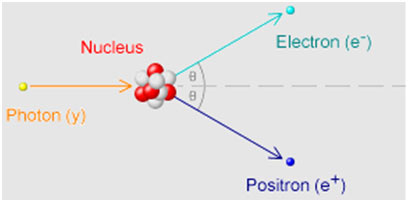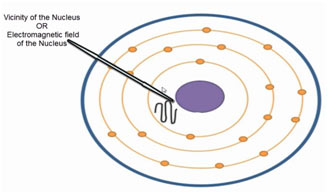Pair Production Effect
Along with the photoelectric effect (photon absorption) and Compton scattering (photon scattering), there is a third process through which photons can lose energy in their interaction with matter.
In this process, described pair production, a photon can merely disappear as well as in its place a matter-antimatter pair of particles can appear. This sensation is an illustration of the fact that mass is not conserved, since the mass of the electron and positron can be developed from the energy of the massless photon.
The photon has to have enough power to produce the remainder masses of both new bits.
Definition
When a high-energy photon is stopped by a heavy nucleus, it converts into an electron-positron pair such a phenomenon is called pair production.
It is an example of the interaction of a very high-energy photon such as γ- rays with matter.
Materialization of Energy
Pair production is also called materialization of energy because according to Einstein’s equation E = mc2. Energy is converted into matter (electron, positron).
Positron
A positron is a particle having mass and charge equal in magnitude to that of the electron but the charge being of opposite in nature i.e., positive. The positron is also called as anti-electron.
Pair production (PP), like the photoelectric effect, leads to the complete attenuation of the incident photon. Pair production can just happen if the incident photon energy is at least 1.022 MeV.

As the photon interacts with the strong electrical field around the center it goes through a change of state and is transformed right into two particles essentially creating matter from energy:
- one electron.
- one positron (antimatter equivalent of the electron).
These two particles form the pair as described in the name of the process.
Conservation of Momentum and Energy
Pair production occurs in the electric vicinity of the heavy nucleus. The nucleus takes the recoil energy along the original direction of a photon to conserve momentum. Pair production cannot take place in vacuum.
Conservation of charge
The charge is conserved in pair production. Photon has zero charge and the net charge of an electron-positron pair is also zero.
Condition for Pair production
The rest mass energy of electron = mᵒ c 2 = 0.51 M eV
The rest mass energy of positron = mᵒ c 2 = 0.51 M eV
Total energy = 2 mᵒ c 2 = 2 x 9.1 x 10 -31 x (3 x 10 8)2
= 2 x 9.1 x 10 -31 x 9 x 10 16
2 x 9.1 x 10 -31 x 9 x 10 16/ 1.6 x 10 -19
= 2 x 0.511 x 10 6
= 1.02 MeV
Thus, the pair production takes place if the maximum energy of a photon is 2 mᵒ c 2
The energy of photon = energy required for pair production + K.E of electron + K.E of positron
Hf = 2 mᵒ c 2 + K.E (e-) + K.E (e+)
MCQs
- What is the Pair Production Effect?
- A) The scattering of photons
- B) The conversion of high-energy photons into matter-antimatter pairs
- C) The absorption of photons by nuclei
- D) The creation of positrons from electrons
- Answer: B
- Which phenomenon is also known as the materialization of energy?
- A) Compton scattering
- B) Photoelectric effect
- C) Pair production
- D) Wave-particle duality
- Answer: C
- What is a positron?
- A) A particle with negative charge
- B) An electron with a positive charge
- C) A particle with the same mass as a proton
- D) The antimatter equivalent of an electron
- Answer: D
- What is conserved during pair production?
- A) Mass only
- B) Charge only
- C) Momentum only
- D) Both charge and momentum
- Answer: D
- Where does pair production occur?
- A) In vacuum
- B) In the presence of strong gravitational fields
- C) In the electric vicinity of heavy nuclei
- D) In the absence of any external fields
- Answer: C
- What is the condition for pair production to occur?
- A) The energy of the photon must exceed 1.022 MeV
- B) The energy of the photon must be less than 0.511 MeV
- C) The energy of the photon must be exactly 1 MeV
- D) The energy of the photon must be greater than 0.511 MeV
- Answer: D
- What particles are produced during pair production?
- A) Proton and neutron
- B) Electron and photon
- C) Electron and positron
- D) Photon and positron
- Answer: C
- How does pair production conserve momentum?
- A) By converting photons into electrons and protons
- B) By absorbing the recoil energy of the nucleus
- C) By creating electron-positron pairs in the vicinity of heavy nuclei
- D) By reversing the direction of the incident photon
- Answer: B
- What is the rest mass energy of an electron?
- A) 0.51 MeV
- B) 1.022 MeV
- C) 9.1 x 10^-31 kg
- D) 9 x 10^16 m/s
- Answer: A
- Which equation represents the energy conservation condition for pair production?
- A) E = mc^2
- B) E = hf
- C) Hf = 2mᵒc^2 + K.E(e-) + K.E(e+)
- D) Total energy = 2mᵒc^2
- Answer: C
- What type of energy conversion does pair production exemplify?
- A) Conversion of kinetic energy into potential energy
- B) Conversion of matter into energy
- C) Conversion of energy into matter
- D) Conversion of nuclear energy into electrical energy
- Answer: C
- What is the charge of a positron?
- A) Positive
- B) Negative
- C) Neutral
- D) Variable
- Answer: A
- Which of the following statements about pair production is true?
- A) Pair production can occur with any energy of incident photons.
- B) Pair production is a process where photons scatter off electrons.
- C) Pair production always results in the creation of a single electron.
- D) Pair production converts energy into matter, creating an electron and a photon.
- Answer: D
- How does pair production contribute to the understanding of mass and energy?
- A) It demonstrates that mass is conserved in all interactions.
- B) It confirms that energy can only be converted into kinetic energy.
- C) It shows that mass can be created from energy under certain conditions.
- D) It proves that energy cannot be converted into matter.
- Answer: C
- What is the role of a heavy nucleus in pair production?
- A) It absorbs the entire energy of the incident photon.
- B) It provides the energy required for the production of matter.
- C) It takes the recoil energy along the original direction of the photon.
- D) It converts photons into electrons and positrons.
- Answer: C
- Which equation represents Einstein’s mass-energy equivalence principle?
- A) E = mc^2
- B) F = ma
- C) KE = 0.5 mv^2
- D) P = mv
- Answer: A
- What is the primary requirement for pair production to occur?
- A) The presence of a magnetic field
- B) The interaction of high-energy photons with heavy nuclei
- C) The collision of electrons with positrons
- D) The absence of any external forces
- Answer: B
- What happens to the total charge during pair production?
- A) It increases
- B) It decreases
- C) It remains constant
- D) It becomes negative
- Answer: C
- How does pair production contribute to the understanding of quantum mechanics?
- A) It demonstrates the wave-particle duality of matter.
- B) It explains the behavior of particles at subatomic levels.
- C) It confirms the conservation of momentum in all interactions.
- D) It shows the relationship between energy and momentum.
- Answer: A
Summary
The tutorial on Pair Production Effect explores a fundamental phenomenon in particle physics, shedding light on the interaction between high-energy photons and matter. Here’s a summary of the key points covered:
- Pair Production Effect: This process involves the conversion of high-energy photons into an electron-positron pair when interacting with matter, demonstrating the conversion of energy into matter.
- Definition: Pair production occurs when a high-energy photon is absorbed by a heavy nucleus, resulting in the creation of an electron and a positron.
- Materialization of Energy: Also known as the materialization of energy, pair production exemplifies Einstein’s equation , where energy is transformed into matter.
- Positron: The positron, or anti-electron, is a particle with mass and a positive charge, serving as the antimatter counterpart to the electron.
- Conservation of Momentum and Energy: Pair production conserves both momentum and energy, with the heavy nucleus absorbing recoil energy to maintain momentum conservation.
- Conservation of Charge: Charge conservation is upheld during pair production, with the net charge of the resulting electron-positron pair being zero.
- Condition for Pair Production: Pair production occurs when the energy of the incident photon exceeds a threshold value, typically around 1.022 MeV.

